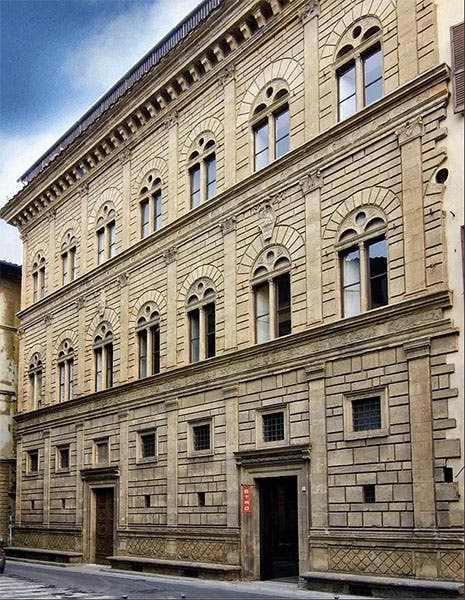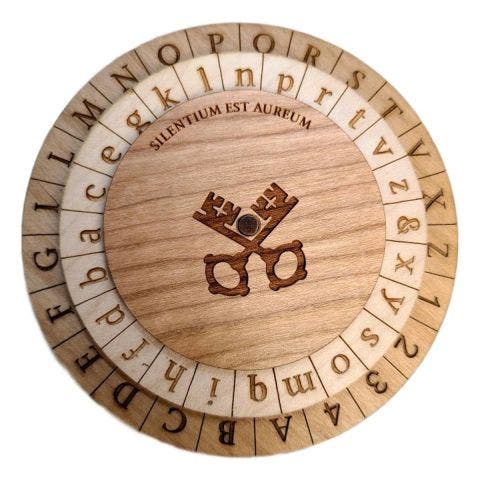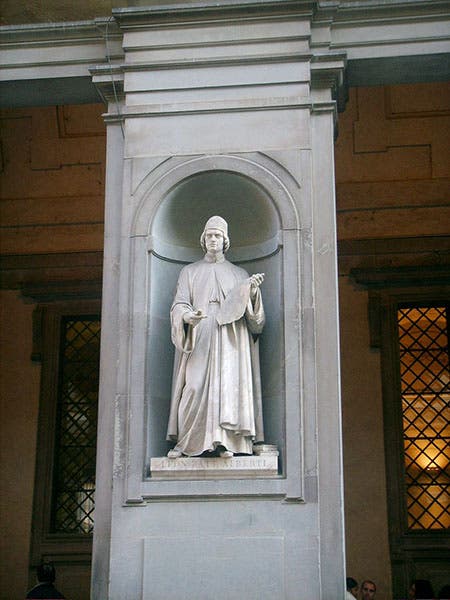Scientist of the Day - Leon Battista Alberti
Leon Battista Alberti, a Renaissance humanist, architect, art theorist, and mathematician, was born either Feb. 14 or Feb. 18, 1404. When most people hear the term "Renaissance man," they think of Leonardo da Vinci, but Alberti is a much better fit – a gifted athlete, a poet, a scholar, an essayist before there were essays, and a man with a command of a variety of the visual arts, including sculpture, painting, and architecture.
Alberti came of age when Filippo Brunelleschi was discovering the principles of linear perspective around 1416, which would transform Renaissance art. However, Brunelleschi did not effect the transformation, as he did not write a treatise on his new methods. It was Alberti who, in 1435, wrote Della pittura, in which he argued that a painter should emulate nature, and that this required the mastery of mathematics and perspective. It was through Alberti that the mathematical technique of perspective spread from Florence to other Italian schools. The book was not printed until later, because, well, there were no printing presses in 1435.
Alberti is best known as an architect. While Brunelleschi was inventing perspective, Poggio Bracciolini was discovering a manuscript of a treatise on architecture by the ancient Roman writer Vitruvius, in which Vitruvius argued that beauty in architecture is determined by number and proportion. Vitruvius also defined the Greek/Roman orders and explained their proper uses. Alberti took Vitruvius as his guide, and he would eventually write his own treatise, Ten Books on Architecture (1452), patterned closely after Vitruvius’s book of the same title. Alberti designed many buildings, only a few of which were set in stone. He designed the façade for Santa Maria Novella in Florence, a medieval cathedral built in the style of Italian gothic (second image, above). The facade looks gothic in its ornamentation, but if you start measuring, you discover that everything is based on Pythagorean proportions: 2/1, 3/2, 4/3, etc. - even the doorways yield proper ratios. And just to add a touch of his own genius, Alberti inserted two large scrolls to cover where the side aisles meet the clerestory, a wonderful solution to a visual problem. Alberti later had the opportunity to design a full church, that of Sant’Andrea in Mantua, which was completed in 1471 and is considered by many to be his finest achievement (third image, just below).
Alberti also helped set the standards for Italian civic architecture, when he designed the façade for the Florentine palace of the Rucellai family (fourth image, below). As with Santa Maria Novella, the façade is laid out on Pythagorean proportions, with classical pilasters and entablatures added according to Vitruvian prescriptions. In addition, the stone is deliberately rusticated, an appealing touch that I do not believe he found in Vitruvius. Soon, other Florentine palaces and villas were following the lead of the Rucellai palace , with similar facades, adding interior courtyards with simple Vitruvian plans and elevations.
Alberti also wrote a book on sculpture, De statua (1464). He was probably a sculptor himself, but none of his works survive, except for his portrait medal (first image), which he is said to have sculpted himself. This specimen is in the wonderful Kress collection of the National Gallery in Washington, D.C.
Lastly, because I find it interesting, I thought I would mention that Alberti made a major contribution to the science of cryptography, the writing and deciphering of codes and ciphers. He invented a cipher device that consists of two concentric wheels, the inner one free to rotate, with upper-case letters and some numbers on the outer wheel, and lower-case letters on the inner wheel. An agreed-upon index letter on the inner wheel is set against a capital letter on the outer wheel, and then the plain text on the outer wheel is converted to a cipher text on the inner wheel. The ingenious feature is that new capital letters are regularly introduced into the cipher, which means changing the position of the index letter on the cipher wheel. What this does is make frequency analysis useless. Most ciphers up until then could be cracked by looking at symbol frequency and assigning the most frequent ones to the most common letters, but that will not work with the Alberti cipher. It was a revolutionary advance, or so the historians of cryptography tell us. The image we show (just above) is a modern Alberti cipher wheel, identical to the one Alberti made in 1467, except this one is made out of wood and is offered for sale, should you wish to pursue the subject.
Alberti died in 1472, at the age of 68. He was buried in the Basilica of Santa Croce in Florence, where he shares grave space with Galileo, Michelangelo, and Machiavelli, not too far from the Pazzi chapel designed by Brunelleschi. There is a statue of Alberti in the courtyard below the Uffizi (sixth image above), where you will find two long rows of prominent Florentines, carved in stone and put in place in the middle of the 19th century. Galileo, Michelangelo, and Machiavelli share that space as well.
We have two 18th-century editions of Alberti’s Ten Books on Architecture in the Library, one in Italian, and one in English. The English translation, a splendid folio of 1755, is available online.
Dr. William B. Ashworth, Jr., Consultant for the History of Science, Linda Hall Library and Associate Professor emeritus, Department of History, University of Missouri-Kansas City. Comments or corrections are welcome; please direct to ashworthw@umkc.edu.










